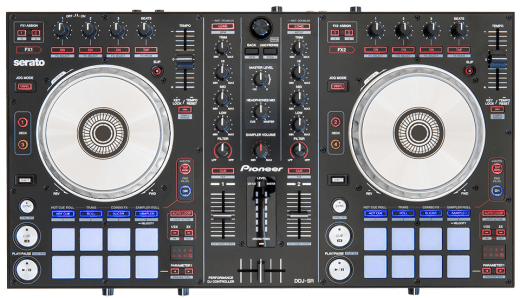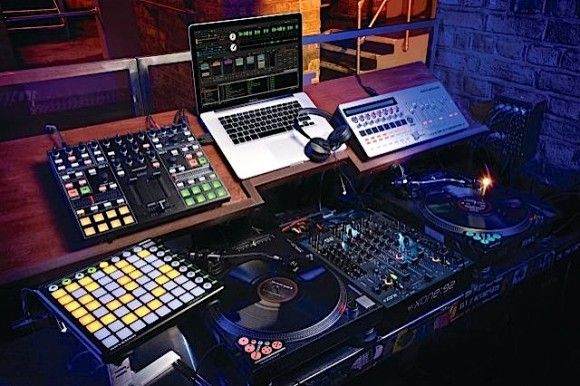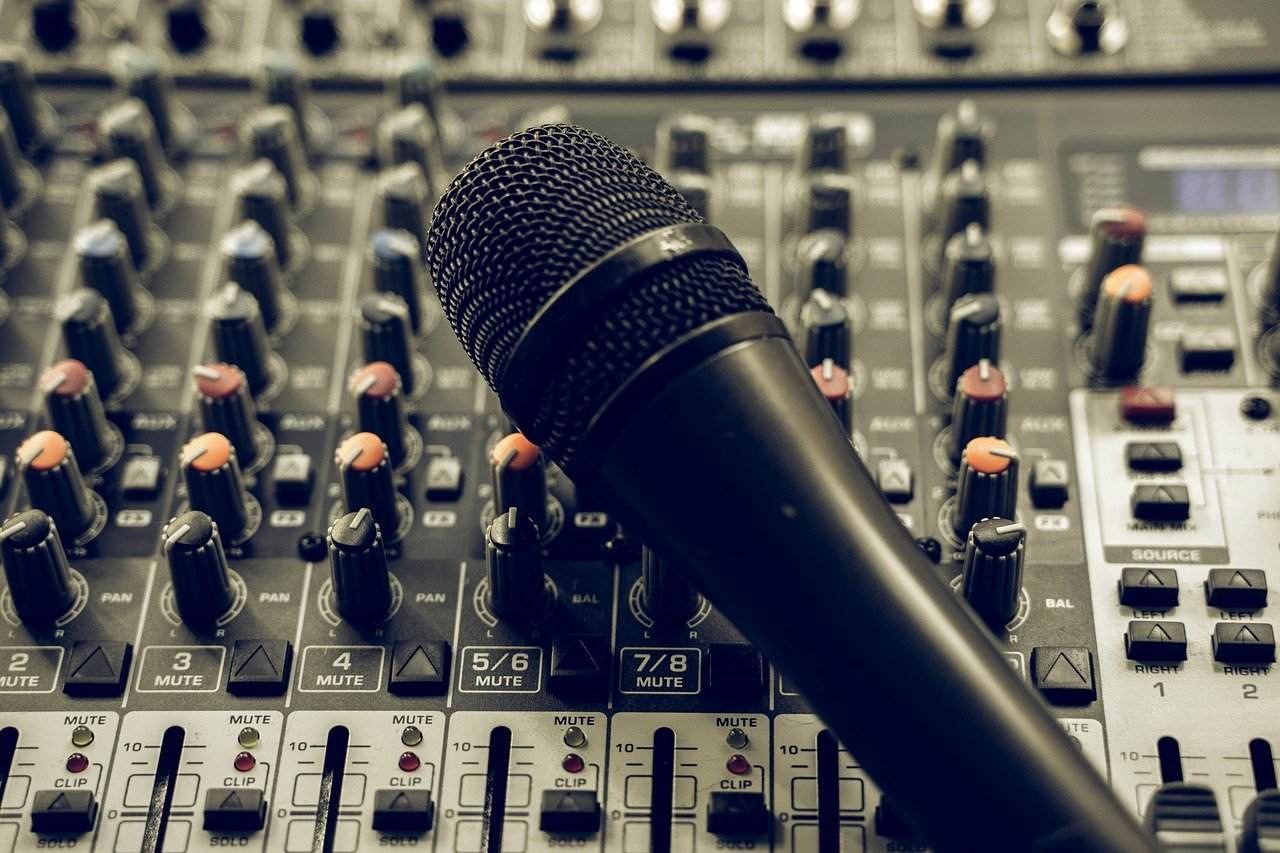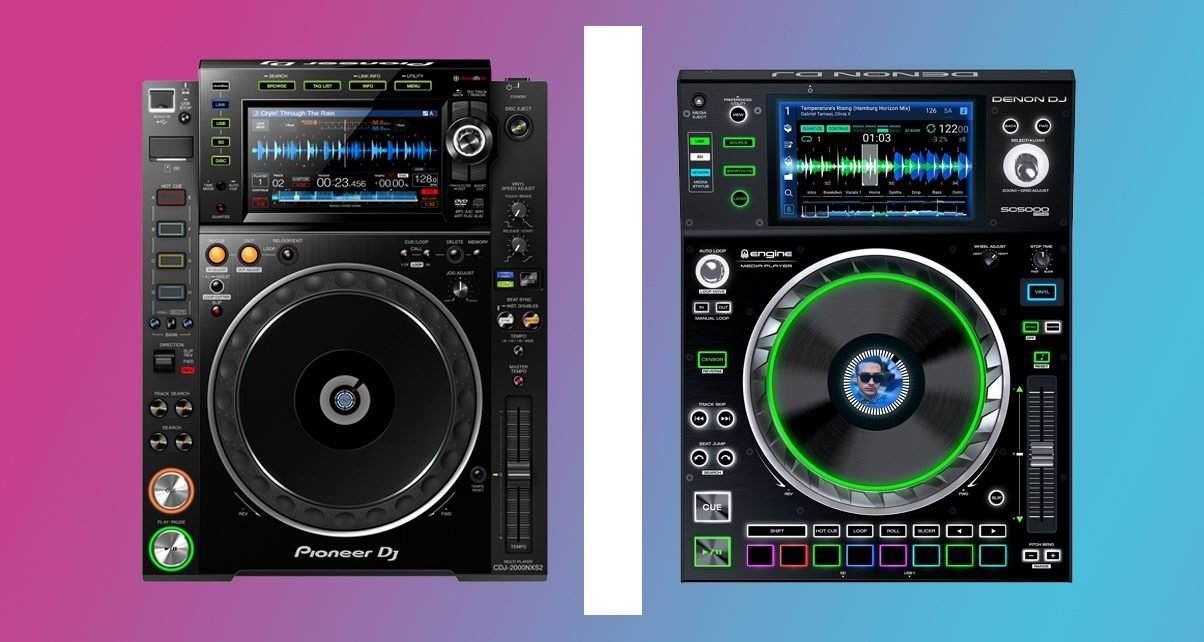Disclosure: This post contains affiliate links, which means we may earn a commission if you purchase through our links at no extra cost to you.
The Pioneer DDJ-SR is a professional and a digital DJ Controller. It fits amazingly within the new Pioneer DDJ controller range because it is a trimmed down two-channel/deck version of the DDJ-SX. It can control all four decks of the Serato DJ, which are virtual. It has a smaller footprint and a new PAD Plus button, which has 16 performance pads. Overall, it has an increased number of features and unique functions than before.
Review and setup
The DDJ-SR has the same overall built quality in collaboration with steel top faceplate, plastic construction underneath, and aluminum jog wheels. It also has the performance pads to control Hot Cues, slicers, rolls, and Sampler. A pad plus button is also available to you. It allows the pads to perform as combo FX, trans, and Sampler Roll, etc. The additional channelized inputs or mixer option is not there in SR, which were there in the DDJ-SX. This system includes an Auxiliary RCA input, which is for emergencies.
If we talk about the build quality, it feels very compact and solid. This DJ controller has an aluminum top jog wheels, an aluminum faceplate, which is for the top panel, and some other metal reinforcements. Plastic has been used for making the sides and bottom of this controller, and because of this, it is durable and has a truly professional feel.
On the sides, there are cut handles, which makes it easy to handle the DDJ-SR. This also makes it comfortable to transport it and carry it on the go. The mixture of plastic and metal is just in the right amount in weight. It isn’t that bad for mobile DJ use. The construction feels sturdy. A soft and rubberized coating is there on EQ and effects knobs. Filter knobs, browse knob, and faders all are having a rigid plastic feel. Everything it has is perfect for Pioneer-branded gear, and it will surely last for a long time.
If we look forward to setting it up, the user can quickly load/reload the drivers or software by using the Software CD. You can use a USB cable which is connected to the computer, add music, and it’s ready to get started. Nowadays, the primary way for setting up software is basically to go to the official website, and from there, download the latest driver update. You must make sure that the controller is operating with the latest stuff.
After all this, the user can then go over to the Serato website. On this website, you can also download the latest Serato DJ software iteration, which is excellent as well. You will be able to install it on your computer. This DJ comes in bundled with the whole and full Serato DJ software, which usually helps you in unlocking its features. There is so much of plug-and-play in this setup. It can merely connect to SR and then start the Serato software, and then all the systems will be ready use.
Then you can plug in speakers and headphones to finish the necessary process of setup. This is entirely USB powered, which means there is no socket for external power. It’s a MIDI mappable device that basically means it can be used with any DJ related software as per your choice.
Features
Input & Output /Front & Back: On the rare panel of DDJ-SR, there are a limited number of inputs and outputs. It would go with most users’ preferences. There is an output that is master in balance, a master switchable output called RCA (comes with its own volume control knob), and RCA input. The RCA input also has its own volume knob for low-level devices such as an MP3 player.
There is an on-off switch and Kensington Lock on its rear panel along with a USB port. Now, On the panel in front, there is this Microphone Input [quarter-inch] having its own volume knob again. In the front, there is a knob known as Crossfader Curve knob, which helps to control the sharpness of the fader and a CF reverse switch.
This knob is very adjustable, which allows you to have a sharp & smoothly drawn-out fade from mixing & also a sharpening. Now on the front left, you will be able to see output for headphones (both 1/4 and 1/8-inch are present) and also the volume control knob for headphones.
Jog Wheels: The jog wheels of this system feel good and perform really great. It has the replaced version of jog wheels from the last model of Pioneer DJ controllers. The new aluminum top is touch-sensitive. The jog wheels can be used to make a proper one-to-one operation within Serato DJ, isn’t it great?
These jog wheels are highly recommended for doing any effective backspins and juggling. These jog spins will get 10/10 because of their light and manageable weight. The sides of this have a dented texture. This allows you to match up the beats. This can be done through nudge or slow down the playing track.
The jog wheels are like a little smaller than the previous model SX, but if we talk about the performance, it remains the same and creates an awesome impact. Jog wheel’s middle part doesn’t have any indicators, like needle indicators or visuals like the DDJ-SX, etc., but the performance level remains the same and excellent.
There is a button on the jog wheels, and it allows you to switch between scratching through [VINYL mode, and [Jog Mode]. There is a button called Slip Mode button on this system that allows the DJ to control or operate the cue points, and use loops, jog wheels, etc. That means you will be able to change a lot of things in the track, which is basically in terms of manipulation when the track still on the beat.
Deck Controls: Deck controls are one of the most sought-after features of this system with the addition of the new pads, and these are 16-performance pads that control several functions. It is an up-gradation to its old model.
The size of these performance pads is a bit smaller than those who were found on the old model, but they still feel almost the same. These pads are for performing and drumming stuff. These also have an excellent and smooth rubberized feel. There are 8 pads per deck, and the exciting part of it is that all of these are velocity-sensitive and also have a backlit to them, which is blue in color.
There is no proper click sound that these pads have, which is the same as one that you get when you press the buttons of Traktor F1, but there’s the backlit whenever any button registers a real hit. The sensitivity of these pads is way too good, that even if you touch the corner by mistake or lightly it will register a hit.
The Pads are handy for controlling these Hot Cues, Slicer, Sampler, and Roll. The Pad Plus button has given each one of these new & original functions, or we can say that it has revived them. It is another relative function which provides much and better possibilities of mixing. You will find a list here.
Hot Cues/Hot Cue Roll – 8 of these pads are so cool and can turn into 8 hot cue points. Now, if you press a cue point pad, it will help you to set a cue point at the time you want to save the Cue. Press the button, and you will be able to recall your cuts and saved tracks.
By holding down, the shift button will allow you to delete any saved cue you wanted to. Drumming in cue points with the pads, trust me, is very satisfying. Plus, it is a lot of fun. If we talk about the Hot Cue Roll, according to the size that is set on autoloop, it will loop/ repeat the hot Cue accordingly.
Roll/Trans – An auto loop for the length that the pad will represent will be started. This is done by the function rolls. The 1st pad is the shortest, then the second one, and so on. It allows the loop to activate whenever pressed because it’s a loop with activated slip-mode—the play-head set back to the normal position when one releases the pad. The volume can be cut in and out at different intervals with the help of trans function.
Slicer/Combo FX – 8 small “slices” can be turned out from, or with the help of these eight pads in the Slicer feature, you can change the single track that is being played. The Slicer basically helps in making 8 small portions of a song that can be rearranged and then can be played back in a unique or different way. It depends on how and when you are hitting the pads.
The cool thing is this software has a perfect memory because it keeps a record of everything. It will have a record of every track you played. If you get a little late to touch the Slicer in, the song’s normal playing position will be achieved. Combo FX allows you to use multiple filters or effects to be more productive and creative.
Sampler/Sampler Roll – There are some samples that are ready for use in this DJ controller. The 2 buttons allow you to scroll through the sample banks, and the 6 buttons in the foremost are the actual sample banks. If you want to play this in a mode that you selected, you have to press this sample button. Sampler Roll mode allows you to play one BPM again and again, till the time you press the pad.
The performance pad section, which is towards the left, has a pad section. This has the hard plastic/shiny Pioneer Play/Pause & Cue buttons. If you want to quickly match the Beats Per Minute [BPM] of the track with the master deck, there is a button on the upper side of this system.
Now there is the separate Loop control area to the right of this performance pad. If you want to activate an auto-loop, you can do it by using this area of the DJ controller. It will help you to be sure that your mix on beat. You will be able to grow a loop or shrink it. You can also select in and out points manually by saving loops to an empty sampler section on the pads. Loops can be transferred as well.
There is an FX1 module on the upper side of this deck on the left side. There is an FX2 module on the right side of it. Both of these are effects modules that have 4 rubberized knobs and an illuminated button underneath and 4 rubberized knobs on these effect modules. Every knob is for setting some different parameters for every single effect. By using the new Serato DJ iZotope effects, three modules can be achieved. It can take some time to adjust your hands on the small Tempo Sliders if you have a habit of using real vinyl or other full-sized DJ controllers. Now there is a lack of sampler controls [SR-6] with the second grip in the DDJ-SR.
Conclusion
In compliment with Serato DJ, the Pioneer DDJ-SR Digital DJ Controller is very great. It is easy to use, durable, professional, and compact. It also provides you the whole creative mixing solution in one small package. This DDJ-SR has amazing 16 velocity-sensitive performance pads that can control every single DJ function. Some examples are hot cues, samples, Roll, and Slicer.
Along with these Pad-Plus features, this DJ controller achieves greater flexibility. There is an emergency input called RCA in Pioneer DDJ-SR through which whenever one faces a software meltdown, they can connect Mp3 players. This system has a resolution that is pretty high, and a crossfader that is used for both, scratching and mixing. It is highly recommended to those who want to show their creativity in every single track they work on; it is classy and amazing to use.





